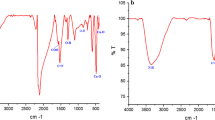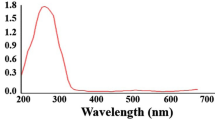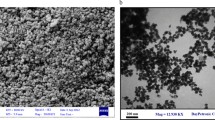Abstract
It has been reported that iron oxide nanoparticles have various biomedical applications, including cancer diagnosis and treatment. Iron oxide nanoparticles were known to exert cytotoxicity against MCF-7 breast cancer cell lines and in this present study, we have investigated for their apoptosis-inducing potential in the same cell line. The flow cytometry analysis of the MCF-7 breast cancer cell lines treated with functionalized iron oxide nanoparticles showed an increased percentage of cells in terms of viable, early, and late apoptosis. The cell cycle analysis of the MCF-7 cell lines treated with Syzygium aromaticum extract coated with polyvinylpyrrolidone (PVP) + iron oxide nanoparticles and PVP + iron oxide nanoparticles showed substantial accumulation of nanoparticles in the sub-G1 phase, confirming induction of apoptosis. The activities of caspase-3, caspase-8, and caspase-9 increased with increasing concentration of the nanoparticles indicating that activities of caspase can be activated by iron nanoparticles. Further, functionalized nanoparticles induced oxidative stress through reactive oxygen species (ROS) formation. Therefore, it is concluded that the functionalized iron nanoparticles induce apoptosis in MCF-7 breast cancer cell lines and further provides an opportunity to explore the iron nanoparticles for apoptosis in cancer treatment.








Similar content being viewed by others
References
Anfosso L, Efferth T, Albini A, Pfeffer U (2006) Microarray expression profiles of angiogenesis-related genes predict tumor cell response to artemisinins. Pharmacogenomics J 6(4):269
Bedard PL, Hansen AR, Ratain MJ, Siu LL (2013) Tumour heterogeneity in the clinic. Natureature 501(7467):355–364
Borghardt JM, Weber B, Staab A, Kunz C, Formella S, Kloft C (2016) Investigating pulmonary and systemic pharmacokinetics of inhaled olodaterol in healthy volunteers using a population pharmacokinetic approach. Br J Clin Pharmacol 81(3):538–552
Caspi RR (2008) Immunotherapy of autoimmunity and cancer: the penalty for success. Nat Rev Immunol 8(12):970–976
Chandrasekaran R, Gnanasekar S, Seetharaman P, Keppanan R, Arockiaswamy W, Sivaperumal S (2016) Formulation of Carica papaya latex-functionalized silver nanoparticles for its improved antibacterial and anticancer applications. J Mol Liq 219:232–238
Cheng CT, Castro G, Liu CH, Lau P (2019) Advanced nanotechnology: an arsenal to enhance immunotherapy in fighting cancer. Clin Chim Acta 492:12–19
Dadfar SM, Roemhild K, Drude NI, von Stillfried S, Knüchel R, Kiessling F, Lammers T (2019) Iron oxide nanoparticles: diagnostic, therapeutic and theranostic applications. Adv Drug Deliv Rev 138:302–325
Day ES, Bickford LR, Slater JH, Riggall NS, Drezek RA, West JL (2010) Antibody-conjugated gold-gold sulfide nanoparticles as multifunctional agents for imaging and therapy of breast cancer. Int J Nanomed 5:445–454
Gao F, Yi J, Yuan JQ, Shi GY, Tang XM (2004) The cell cycle related apoptotic susceptibility to arsenic trioxide is associated with the level of reactive oxygen species. Cell Res 14:81–85
Gmeiner WH, Ghosh S (2015) Nanotechnology for cancer treatment. Nanotechnol Rev 3(2):111–122
GolombekSK MJN, Theek B, Appold L, Drude N, Kiessling F, Lammers T (2018) Tumor targeting via EPR: strategies to enhance patient responses. Adv Drug Deliv Rev 130:17–38
Gupta K, Chhibber S (2019) Biofunctionalization of silver nanoparticles with lactonase leads to altered antimicrobial and cytotoxic properties. Front Mol Biosci 6:63
Hathaway HJ, Butler KS, Adolphi NL, Lovato DM, Belfon R, Fegan D, Monson TC, Trujillo JE, Tessier TE, Bryant HC, Huber DL, Larson RS, Flynn ER (2011) Detection of breast cancer cells using targeted magnetic nanoparticles and ultra-sensitive magnetic field sensors. Breast Cancer Res 13(5):R108
Hua S, de Matos MBC, Metselaar JM, Storm G (2018) Current trends and challenges in the clinical translation of nanoparticulate nanomedicines: pathways for translational development and commercialization. Front Pharmacol 9:790. https://doi.org/10.3389/fphar.2018.00790
Ma J, Chen CS, Blute T, Waxman DJ (2011) Antiangiogenesis enhances intratumoral drug retention. Can Res 71(7):2675–2685
McGowan EM, Alling N, Jackson EA, Yagoub D, Haass NK, Allen JD, Martinello-Wilks R (2011) Evaluation of cell cycle arrest in estrogen responsive MCF-7 breast cancer cells: pitfalls of the MTS assay. PLoS ONE ONE 6(6):e20623
Palanisamy S, Wang YM (2019) Superparamagnetic iron oxide nanoparticulate system: synthesis, targeting, drug delivery and therapy in cancer. Dalton Trans 48(26):9490–9515
Panicker NG, Balhamar SOMS, Akhlaq S, Qureshi MM, Rizvi TS, Al-Harrasi A, Hussain J, Mustafa F (2019) Identification and characterization of the Caspase-mediated apoptotic activity of Teucrium mascatense and an isolated compound in human cancer cells. Molecules 24(5):E977. https://doi.org/10.3390/molecules24050977
Sanna V, Pala N, Sechi M (2014) Targeted therapy using nanotechnology: focus on cancer. Int J Nanomed 9:467–483
Srinithya B, Kumar VV, Vadivel V, Pemaiah B, Anthony SP, Muthuraman MS (2016) Synthesis of biofunctionalized AgNPs using medicinally important Sida cordifolia leaf extract for enhanced antioxidant and anticancer activities. Mater Lett 170:101–104
Thenmozhi T, Rasajna N, Rajesh M, Sushma NJ (2019) Biosynthesis and characterization of iron oxide nanoparticles via Syzygium aromaticum extract and determination of its cytotoxicity against human breast cancer cell lines. J Nanosci Technol 5:587–592
Wang L, Li C, Huang Q, Fu X (2019) Biofunctionalization of selenium nanoparticles with a polysaccharide from Rosa roxburghii fruit and their protective effect against H2O2-induced apoptosis in INS-1 cells. Food Funct 10(2):539–553
Yadav R, Saini H, Kumar D, Pasi S, Agrawal V (2019) Bioengineering of Piper longum L. extract mediated silver nanoparticles and their potential biomedical applications. Mater Sci Eng C 104:109984
Acknowledgements
The author highly thankful to Dr. John Sushma, Assistant Professor, Department of Biotechnology, SPMVV, Tirupati, India for her kind guidance and for providing instrumentation facilities.
Author information
Authors and Affiliations
Contributions
T.T. designed the experiments, carried out the experiment and wrote the manuscript.
Corresponding author
Ethics declarations
Conflict of interest
The authors declare that there is no conflict of interest.
Ethical approval
This work do not require ethical approval.
Electronic supplementary material
Below is the link to the electronic supplementary material.
Rights and permissions
About this article
Cite this article
Thenmozhi, T. Functionalization of iron oxide nanoparticles with clove extract to induce apoptosis in MCF-7 breast cancer cells. 3 Biotech 10, 82 (2020). https://doi.org/10.1007/s13205-020-2088-7
Received:
Accepted:
Published:
DOI: https://doi.org/10.1007/s13205-020-2088-7




